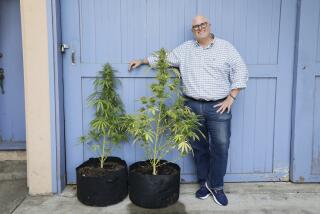GARDENING : From Tiny Seeds Mighty Difficult Projects Can Grow
- Share via
One of the dangers of gardening is allowing enthusiasm to gain the upper hand. A gardening friend encouraged by early success outdoors decided to start seeds indoors.
The decision to grow his own seedlings made sense: Why pay good money for plants, especially when it has become clear how easy they are to grow? Initial success in the garden has a way of imparting a profound belief in one’s ability to grow anything anywhere. Would that plants could thrive on little more than the fervor of gardeners.
Several weeks into his seed-starting project, my friend’s zeal had waned to guarded optimism. His problems: The young seedlings he’d so carefully sprouted in potting mix in the warmth of his kitchen now were tall and gangly; some actually drooped and fell sideways; they were crowded together, and he knew that at some point he’d have to separate them, but how?
And a white mold-like deposit had appeared on the outside of the peat pots he was using--was this a matter of concern?
This novice gardener might have been flushed with victory after two summers of glorious blooms and bountiful harvests, but he was beginning to understand that for seed starting, providing nature’s growing stimuli--warming earth, lengthening days and spring showers--is a lot harder than you might think.
Like a thriving garden, a successful indoor seedling project is enormously satisfying, which makes it worth attempting. But without the right ingredients, it is frustrating and pretty much a waste of time and money.
For example, there is no point in trying to grow seedlings indoors unless you have more light than you can imagine needing. A greenhouse would do the job; so would fluorescent or special ultraviolet growing lights that are placed very close to plants and left on for 16 hours a day.
Anything less will result in something very like what my eager friend experienced: gangly, floppy seedlings with weak stems. When plants need light, they respond by reaching for it to the exclusion of all other activity; they cannot build healthy, strong tissue. In the end, they die.
Another ingredient necessary for a successful seedling operation is dedicated space, and plenty of it. Getting plants from sprouts to specimens that are ready for transplanting into the garden requires a number of stages, each of which commands increasingly more space.
Example: You sow one to three seeds in a one-inch-square container, typical for seed starting and available at any garden center. Most likely, you’ll have a “pack” of this sized container, six one-inch cells attached together; perhaps these would be multiplied further by having more than one “pack”--up to, say, six of these on a tray.
Such an assemblage typically would measure 6 inches by 6 inches and allow for 36 individual plants to be grown in each cell (after other seedlings are thinned). That’s Stage One. Once the young sprouts have formed a couple of “true” leaves, miniature versions of adult foliage, they are ready to be moved to larger quarters.
This is done not only to give them additional soil in which to stretch their roots but also because each time they are transplanted--and this must be done with extraordinary gentleness, for it takes very little to injure the fragile seedlings--the young plants are placed deeper into the planting medium.
Soil is painstakingly mounded around the base of the seedling to come up as high on the stem as possible. This practice forces the small plants into a burst of vigorous growth with each transplanting; stems are stronger, roots sprout along stems, delivering more nutrients to plants; foliage thrives.
The trick, though, besides setting the seedlings down into the soil, is to move up to larger pots with each transplant stage. For some plants, such as tomatoes and peppers, there might be two or three of these transplanting phases.
So think about that first batch of 36 plants and the space they need. Next, they must go into pots that are 2 inches by 2 inches--quadrupling the size of their quarters. Another transplanting may be necessary as the seedlings grow: still more space.
Trying to contain the operation can doom it: Crowded seedlings, whether stuffed into one pot or in the close confines of one-inch pots, tend to suffocate one another.
The last ingredient needed is one that most gardeners have in abundance: devotion. Seedlings have to be checked daily for signs they are ready to go into the garden. If they are getting too tall, if they need to be watered every day, if foliage is becoming discolored, they need more room.
Light has to be regulated. Apart from exposing seedlings to 16 hours of artificial light per day, the light source itself will need to be raised or lowered according to the height of plants: The light should be maintained two to four inches above foliage; I prefer the closer positioning.
Seedlings need misting against dry conditions, but beware of excessive watering and inadequate light--conditions that promote a deadly fungal disease called damping off. This is also linked to using unsterilized soil. Avoid garden soil--money spent on sterilized potting mixes is well invested.
If all this sounds daunting, it is meant only to warn against setting oneself up for failure.
In fact, starting seedlings of the many annual vegetables and flowers that grow so lushly in our gardens is gratifying, not too difficult and worth the effort if the three main ingredients of light, space and commitment are available in abundance.






